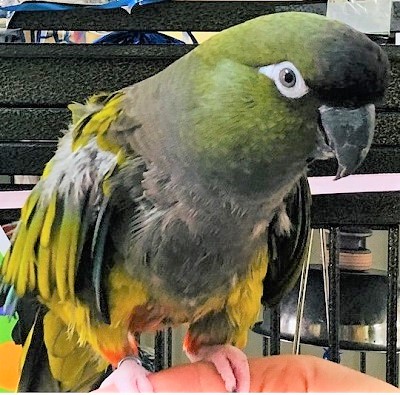
Today is Halloween which means it’s the last day of October and that it’s time to bid our Animal of the Month a fond farewell. And while our featured creature, the Patagonian conure, enjoyed his time in the spotlight, he is also anxious to join in on some Halloween antics. We hope you enjoyed following us on Twitter @ExoticPetVets as we tweeted all month long about these “little clowns.” If you missed any of our tweets, here is a summary that is always available for your reference. Did you know?:
- The Patagonian conure (Cyanoliseus patagonus) is a medium-sized bird endemic to – you guessed it – Patagonia! Well, at least parts of Patagonia.
- Patagonia is not a country, but rather a geographical region. It encompasses the southern end of South America and is shared by Chile and Argentina. But despite their name, Patagonian conures are not found throughout the entire region.
- From the southern-most part of their range, which is within Patagonia, Patagonian conures are found from southeast and central Argentina to the northwestern part of the country.
- There are only a couple of isolated populations of Patagonian conures in central Chile.
- The Patagonian conure population that is found in central and southeastern Argentina is known to occasionally migrate north to southern Uruguay during the winter months.
- In the wild, Patagonian conures favour open and arid habitats; including, steppes (open grassland), savannas and the Chaco plains (semi-arid lowlands in northern Argentina).
- The Patagonian conure is the largest species of conure, with adults having an average length of 18 inches (46 cms). Their plumage can be described as colourful yet somewhat understated.
- Patagonian conures have heads and upper backs that are an olive colour. They have a bare white ring around their eyes and dark grey-black beaks. Their feet are a pinky-white colour.
- While they have a loose and inconsistent pectoral band of white feathers, grey feathers cover the rest of Patagonian conures’ chests. They have a patch of orange-red feathers on their abdomens and on their thighs.
- Patagonian conures have yellow feathers on their flanks, lower backs and rumps.
- Their long, tapered tails make up about half of the Patagonian conure’s entire length. There are yellow feathers on the top part of his tail – the rest being an olive green colour with blue tints.
- The Patagonian conure’s upper wing feathers (wing coverts) are olive green while the primaries (outer wing feathers) are blue.
- Sexual dimorphism means there are visible physical differences between the genders of a species. Patagonian conures are considered dimorphic because the males are a bit larger than females.
- The abdominal patches on male Patagonian conures are also generally bigger and redder than those on their female counterparts. But there’s more than meets the eye.
- In addition to being sexually dimorphic, researchers in Germany have discovered that Patagonian conures are also sexually dichromatic, meaning each gender displays two different colours – even though humans can only see one.
- The researchers looked at Patagonian conures under black light (UV light) and found that the males have brighter green feathers compared to the females, while the females have brighter blue feathers.
- Like all birds, Patagonian conures can see many more colours than humans can because they have more colour cones in their retina. This gives them the ability to see colours that are in the ultraviolet range.
- Patagonian conures are also commonly known as burrowing parrots – and there’s a very good reason for that.
- Like all parrot species, Patagonian conures are cavity nesters; meaning, they build their nests inside holes in trees, burrows or other protective structures. But compared to other parrots, Patagonian conures have excavation skills that are beyond compare.
- Because they are highly social and nest in large colonies, Patagonian conures will excavate elaborate interconnected burrows in earth, limestone or sandstone cliff faces that can be as deep as three metres (9.8 feet).
- The largest parrot colony in the world was created by Patagonian conures and boasts about 37,000 nests. It’s situated along a 12.5 km stretch in the cliffs of Balneario El Cóndor along northern Argentina’s Atlantic coast.
- Even though Patagonian conures are very social and live in large flocks, they are monogamous and mate for life. Their breeding season in the wild is between September and February.
- Patagonian conures will lay between 2-5 eggs, which will hatch after an incubation period of about 24-25 days.
- Patagonian conure hatchlings will be able to fly at around eight-weeks of age, but they continue to be dependent on their parents for food for several months afterward.
- In the wild, Patagonian conures will eat berries, fruits and seeds, which they either forage for on the ground or from plants such as the giant thistle.
- Patagonian conures will also consume grain. In 1984 they were legally declared agricultural pests in Argentina – and are heavily persecuted as a result. But researchers say this legal designation is unfounded.
- German and Argentinian researchers looked at the grain consumed by Patagonian conures. They found that the birds mostly eat either unharvested, leftover or grain that was spilled while being harvested.
- The researchers say crop damage by Patagonian conures is negligible and their overall impact on Argentina’s agricultural sector has been greatly exaggerated by people who considered them pests.
- If Patagonian conures were going to dress up for Halloween, they would likely wear clown costumes. Because of their sweet and playful nature, they’re affectionately called “little clowns” by aviculture enthusiasts.
- Patagonian conures are also very intelligent and in captivity need a lot of attention and affection from their human family – along with games and toys to keep them from getting bored.
- In the wild, Patagonian conures can live an average of about 20 years. But with good care in captivity, they have an average lifespan of about 30 years.

